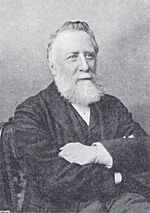George James Symons facts for kids
Quick facts for kids
George James Symons
|
|
|---|---|

George James Symons
|
|
| Born | 6 August 1838 |
| Died | 10 March 1900 (aged 61) |
| Nationality | British |
| Awards | Albert Medal (1897) |
| Scientific career | |
| Fields | Meteorology |
George James Symons (born August 6, 1838 – died March 10, 1900) was a British scientist who studied weather, especially rainfall. He is famous for starting the British Rainfall Organisation. This was a huge network of places across Britain and Ireland that collected rainfall data. He was also a Fellow of the Royal Society, a group of important scientists.
Contents
Life and Work
George James Symons was born in Pimlico, London, on August 6, 1838. He was the only child of Joseph Symons and Georgina Moon. He went to school at St. Peter's collegiate school and later had private lessons. He also studied at the school of mines in Jermyn Street.
Early Interest in Weather
From a young age, George was very interested in the weather. He even built his own weather tools! When he was just seventeen, he joined the Royal Meteorological Society. This is a group for people who study weather. He later became a leader in this society, serving as secretary and even president.
Starting the British Rainfall Organisation
In 1857, George started working as a weather reporter for the government. In 1860, he got a job in the weather department of the board of trade. But he left this job after three years. He needed more time for his own big project: collecting rainfall information.
In 1860, he published his first book of rainfall statistics. It included records from 168 places in England and Wales. By 1898, his network had grown huge! There were 3,404 stations, with 436 in Scotland and 186 in Ireland. More than three thousand volunteers helped him collect this data.
This amazing network was unique. George Symons personally checked on all the stations. This helped him gather a lot of important information about rainfall. He believed this information was very important for managing water supplies and public health.
Other Contributions
In 1863, George started a monthly newsletter about rain. This later became the Monthly Meteorological Magazine in 1866, which is still published today. He was also part of many committees for the British Association.
In 1878, he became a fellow of the Royal Society. He led a committee that studied the huge volcanic eruption of Krakatoa in 1883. He also helped write a very detailed report about it in 1888.
George Symons received several awards for his work. In 1876, he won the Telford premium for a paper about floods. In 1897, he received the Albert medal. This award was for his great work in collecting rainfall data across the United Kingdom.
He was also a member of many other science groups, both in Britain and other countries. In 1891, he was made a chevalier of the legion of honour in France.
George Symons became ill in February 1900 and passed away on March 10, 1900. He was buried in Kensal Green cemetery.
Family Life
In 1866, George Symons married Elizabeth Luke. She helped him with his work. Sadly, she passed away in 1884. Their only child died when they were a baby.
Lasting Impact
George Symons's work on rainfall continued after his death. His helper, H. Sowerby Wallis, took over. The Royal Meteorological Society created a special award in his honor, called the Symons Gold Medal. This medal is given to people who do great work in weather science.
George kept detailed weather records at his home in Camden Square for 42 years. He was known for being a friendly person who got along well with everyone.
Books and Publications
George Symons had a very large library with ten thousand books and pamphlets. Besides his many essays and reports, he wrote several books:
- Rain: how, when, where, why it is measured, London, 1867.
- Pocket Altitude Tables, London, 1876. This book had three different versions.
- The Floating Island in Derwentwater, London, 1889.
- He also helped publish old weather records, like Merle's MS. Consideraciones Temperiei pro 7 Annis 1337-1344, in 1891.
- He edited Theophrastus on Winds and Weather Signs, in 1894.

